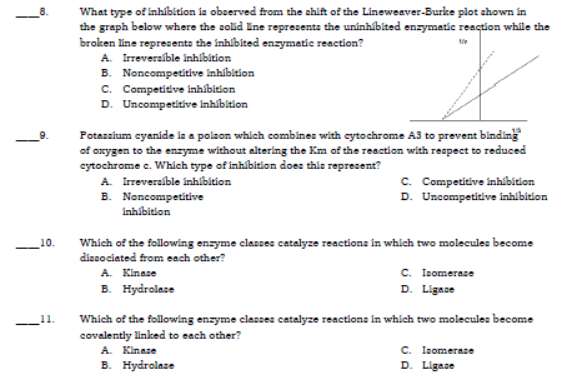What type of inhibition ia observed from the ahift of the Lineweaver-Burke plot ahown in the graph below where the solid Ine represente the uninhibited enzymatic reaction while the broken line representa the inhibited enzymatic reaction? A. Irreveraible inhíbition B. Noncompetitive Inhíbition C. Competitive inhibition D. Uncompetitive inhibition
What type of inhibition ia observed from the ahift of the Lineweaver-Burke plot ahown in the graph below where the solid Ine represente the uninhibited enzymatic reaction while the broken line representa the inhibited enzymatic reaction? A. Irreveraible inhíbition B. Noncompetitive Inhíbition C. Competitive inhibition D. Uncompetitive inhibition
Biochemistry
9th Edition
ISBN:9781319114671
Author:Lubert Stryer, Jeremy M. Berg, John L. Tymoczko, Gregory J. Gatto Jr.
Publisher:Lubert Stryer, Jeremy M. Berg, John L. Tymoczko, Gregory J. Gatto Jr.
Chapter1: Biochemistry: An Evolving Science
Section: Chapter Questions
Problem 1P
Related questions
Question

Transcribed Image Text:What type of inhibition is observed from the shift of the Lineweaver-Burke plot ahown in
the graph below where the solid Ine represents the uninhibited enzymatic reaction while the
broken line represents the inhibited enzymatic reaction?
A. Irreveraible inhíbítion
B. Noncompetitive inhíbition
C. Competitive inhíbition
D. Uncompetitive inhibition
Potassium cyanide ia a polson which combines with cytochrome A3 to prevent binding
of oxygen to the enzyme without altering the Km of the reaction with respect to reduced
cytochrome c. Which type of inhibition does this represent?
A. Irreveraible inhibition
c. Competitive inhibition
D. Uncompetitive inhibition
B. Noncompetitive
inhibition
_10.
Which of the following enzyme classes catalyze reactions in which two molecules become
dissociated from each other?
A. Kinase
в. Нуdrolase
c. Isomerase
D. Ligase
Which of the following enzyme classes catalyze reactions in which two molecules become
covalently linked to each other?
A. Kinase
B. Hydrolase
1.
C. Isomerase
D. Ligase
Expert Solution
This question has been solved!
Explore an expertly crafted, step-by-step solution for a thorough understanding of key concepts.
This is a popular solution!
Trending now
This is a popular solution!
Step by step
Solved in 3 steps

Recommended textbooks for you

Biochemistry
Biochemistry
ISBN:
9781319114671
Author:
Lubert Stryer, Jeremy M. Berg, John L. Tymoczko, Gregory J. Gatto Jr.
Publisher:
W. H. Freeman

Lehninger Principles of Biochemistry
Biochemistry
ISBN:
9781464126116
Author:
David L. Nelson, Michael M. Cox
Publisher:
W. H. Freeman

Fundamentals of Biochemistry: Life at the Molecul…
Biochemistry
ISBN:
9781118918401
Author:
Donald Voet, Judith G. Voet, Charlotte W. Pratt
Publisher:
WILEY

Biochemistry
Biochemistry
ISBN:
9781319114671
Author:
Lubert Stryer, Jeremy M. Berg, John L. Tymoczko, Gregory J. Gatto Jr.
Publisher:
W. H. Freeman

Lehninger Principles of Biochemistry
Biochemistry
ISBN:
9781464126116
Author:
David L. Nelson, Michael M. Cox
Publisher:
W. H. Freeman

Fundamentals of Biochemistry: Life at the Molecul…
Biochemistry
ISBN:
9781118918401
Author:
Donald Voet, Judith G. Voet, Charlotte W. Pratt
Publisher:
WILEY

Biochemistry
Biochemistry
ISBN:
9781305961135
Author:
Mary K. Campbell, Shawn O. Farrell, Owen M. McDougal
Publisher:
Cengage Learning

Biochemistry
Biochemistry
ISBN:
9781305577206
Author:
Reginald H. Garrett, Charles M. Grisham
Publisher:
Cengage Learning

Fundamentals of General, Organic, and Biological …
Biochemistry
ISBN:
9780134015187
Author:
John E. McMurry, David S. Ballantine, Carl A. Hoeger, Virginia E. Peterson
Publisher:
PEARSON